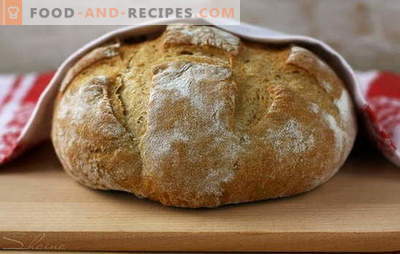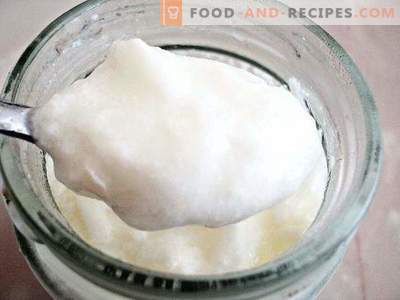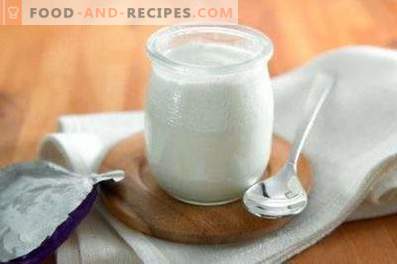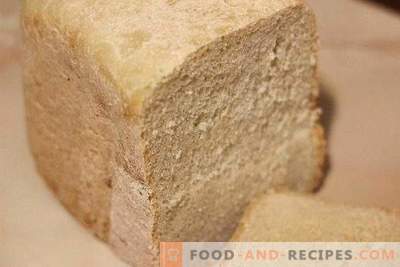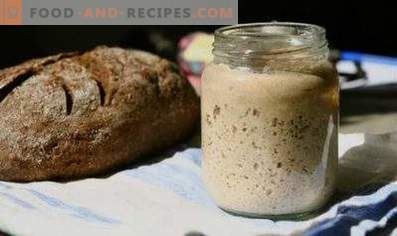
Not all housewives are satisfied with the quality of the purchased bread. Sometimes it turns out to be poorly baked or sometimes burnt, sometimes foreign elements are found in it. More confused by the specific smell, which can not be called appetizing. Information periodically appears in the media that some manufacturers, in order to reduce the cost of a loaf, bake it from low-grade flour and artificial additives that make their products dangerous to health. Wanting to protect their loved ones from various ailments and feed them tasty, fragrant and healthy bread, many begin to master the baking art themselves. Studying the recipes of their grandmothers, some hostesses resurrected baking recipes without yeast, on bread sourdough. According to this technology, flour is fermented naturally, fermentation is caused not by artificially derived fungi, but by lactic acid bacteria that are not foreign to our body. Sourdough bread is prepared quite simply for rye bread; for most cooks it comes out the first time. If your bakery experience is small, it is best to begin to master the basics of baking skill.
Cooking Features
Sourdough for rye bread is made from rye flour, which can be leavened in several ways. Some recipes do not require the use of any other products other than flour and water. Other options involve the use of hop cones, raisins, and other ingredients. The starter preparation technology may depend on a specific recipe, but following a few rules will be required anyway.
- For preparing the leaven, it is recommended to take wholemeal flour or even to use the grain itself, then it fits faster and becomes more stable. However, on the market it is easier to find rye flour, ground finely and intended for making homemade cakes. It is also quite suitable for the production of bread sourdough, just the result will have to wait a little longer. If there is a choice between expensive and cheap rye flour, you can safely choose the cheap one: it will not affect the quality of the starter.
- It is advisable to take boiled water to prepare bread sourdough, so that bacteria that may be in raw water do not contribute to the development of pathogenic microflora, causing putrefaction instead of fermentation. An alternative could be pure spring water, for which you have absolute certainty.
- Before fermenting flour, the water must be cooled to 35-40 degrees. If you use cold or hot water, fermentation may not be possible.
- Sourdough is cooked in a wooden, earthenware or glass dish. Plastic and metal can adversely affect the process. Modern housewives prefer glass jars. The volume of the jar must be several times larger than the volume of the starter, since during fermentation it greatly increases in size.
- It is not recommended to close the jar tightly, otherwise the leaven will “suffocate”. Usually the banks are tied up with gauze or a very thin cloth. You can cover it with cling film, but then you need to make several holes in it with a toothpick.
- In a warm room, the fermentation process begins earlier and is more active. For fermentation, the flour mixture with other products is kept at a temperature not lower than room temperature. The optimum temperature is 24-26 degrees.
- It is also recommended to keep the sourdough jar in a place protected from light and drafts.
- In the first days, the leaven should be mixed 3-6 times a day, so that it does not acid.
Ready starter can be stored in the refrigerator, every week feeding a mixture of boiled water and rye flour. If you keep the leaven at room temperature, then “dressing” is necessary every day or at least once every two days.
If the starter is stored in the refrigerator, it is required to “wake up” before use. It is moved to a warm place, “fed up” and left for 8-12 hours. After this, you can make a brew from the leaven, knead the dough on it and bake the bread.
Sourdough rye flour is suitable for making rye and rye-wheat bread. Wheat bread to make it will not work.
“Eternal” starter on rye flour
Composition:
- rye flour - 150 g;
- boiled water - 150 ml.
Method of preparation:
- Boil the water, cool it to about 35-40 degrees.
- Pour 50 g of water, add 50 g of flour to it. Stir products. Transfer to a 1-liter glass jar.
- Bind the neck of the jar with gauze. Place it in a kitchen cupboard or other warm and dark place.
- For the first two or three days, just observe the behavior of the mixture, stirring it at least 3-4 times a day.
- When the leaven will show clear signs of fermentation, blistering and starting to increase in volume, feed it. To do this, combine 50 g of flour with 50 ml of warm boiled water, mix. Then add the fresh mixture to the starter.
- For the next day, continue to monitor the sourdough without stirring it. At some time it will rise, significantly increasing in volume. If this happens at night, then in the morning you will find traces on the bank of the leaven that had risen and then descended or began to descend. Finding similar symptoms, feed the sourdough again. To do this, take a teaspoon of leaven, add to it 25 g of flour and 25 ml of water, mix. The prepared mixture, enter to leaven.
- The next day, again, feed the leaven with the same mixture as the previous time.
A day later, the leaven can be used to make bread. If you take only half or less, then the rest can be made “eternal”. To do this, you need to put it in the fridge and feed it every week with the same composition: 1 part starter, 2 parts flour and water. When stored indoors, “feeding” should be done at least every other day. Then the leaven for rye bread will always be at your fingertips and never spoil.
Sourdough for rye raisin bread
Composition:
- wheat flour - 0, 24 kg;
- water - how much will leave (approximately 0, 3 l);
- sugar - 5 g;
- raisins - 100 g.
Method of preparation:
- Pour the raisins and sugar into a bowl. Squash them with a crush.
- Mix 80 g of rye flour and 120 ml of warm boiled water separately. Pour this mixture into a container with raisins, mix.
- Place the resulting mixture in a jar, wrapping it around the neck with a cloth. Put in a warm dark place.
- The next day, strain the mixture through a large-mesh screen to separate the raisins, but not the flour.
- Mix 80 g of flour and 80 ml of water, combine this mixture with the filtered mass. Pour the leaven back into the jar and place in the heat.
- On the third day, split the leaven in half. In one part, add 80 g of flour and dilute the mixture with boiled water to the consistency of sour cream. This part must be left in a refrigerator to be used later.
The rest can be immediately used for making bread or, like the first one, to feed and send for storage in a cool place.
Sourdough for rye bread on hops
Composition:
- dried hop cones - 50 g;
- water - 0, 25 l;
- honey - 10 ml;
- rye flour - how much will leave (approximately 80-100 g).
Method of preparation:
- Pour the hops into the hops. Bring the liquid to a boil. Boil until its volume is halved.
- Place the broth in a thermos and leave for 3-4 hours. Strain.
- When the broth has cooled to about 35-40 degrees, dissolve the honey in it. Add flour and stir in it, until you get a composition, the consistency of sour cream.
- Place the starter in the jar, cover it with a cloth. Put the sourdough jar in the heat and wait until the sourdough ferments. Let her wander for 36-48 hours and use as directed.
Such a leaven can be used to make Borodino bread.
Sourdough for rye bread is made easy, but when preparing it, you must follow all the instructions that accompany the recipe, and do not overlook any trifles. Then the leaven of rye flour will “live” for a long time, and baking from it will always turn out tasty and appetizing.







